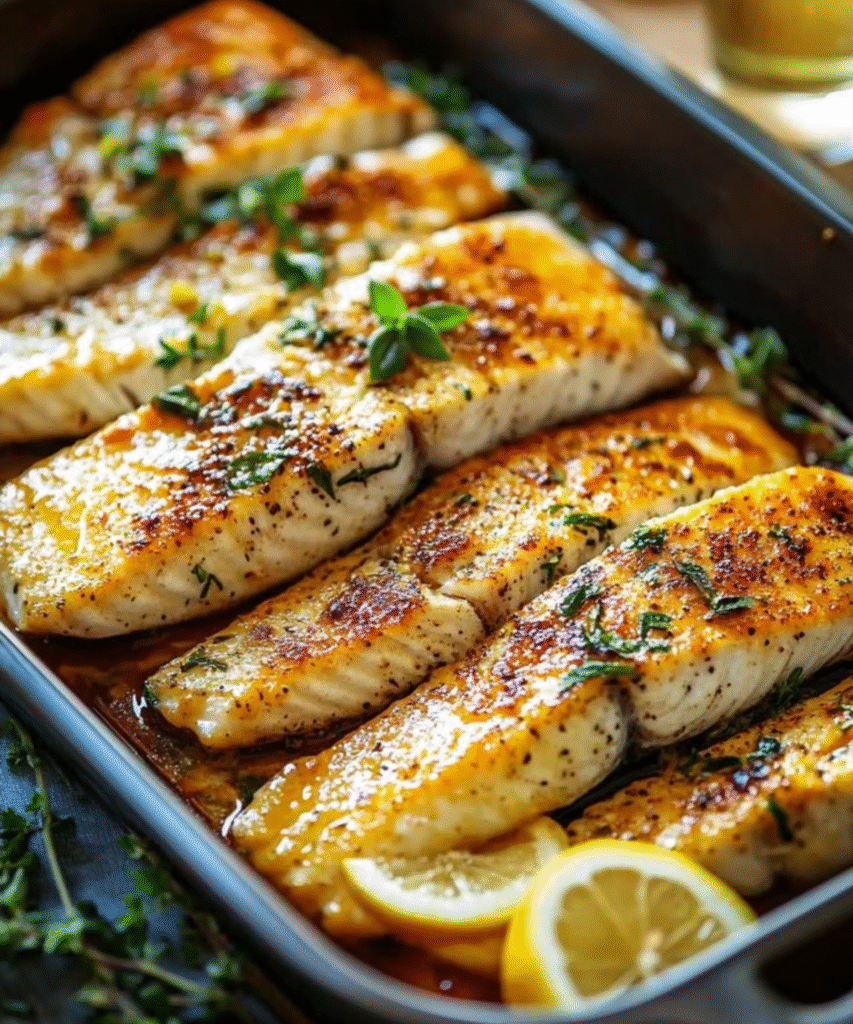This elegant lemon and thyme roasted sea bass transforms a simple whole fish into a restaurant-quality centerpiece with minimal effort and maximum flavor. The aromatic combination of fresh herbs, bright citrus, and flaky sea bass creates an impressive dish that’s surprisingly achievable for home cooks. With proper technique, you’ll achieve perfectly cooked fish with crispy skin and moist, tender flesh every time.
Recipe Details
Prep Time: 15 mins
Cook Time: 25 mins
Total Time: 40 mins
Servings: 4-6
Difficulty: Medium
Ingredients
For the Sea Bass
- 1 whole sea bass (1.5-2kg), cleaned and scaled
- 2 lemons, sliced into rounds
- 6-8 fresh thyme sprigs
- 4 garlic cloves, sliced
- 3 tablespoons extra-virgin olive oil
- 2 teaspoons sea salt
- 1 teaspoon freshly ground black pepper
- 2 tablespoons fresh thyme leaves, stripped from stems
For the Herb Butter
- 100g unsalted butter, softened
- 2 tablespoons fresh lemon juice
- 1 tablespoon lemon zest
- 2 tablespoons fresh thyme leaves
- 2 garlic cloves, minced
- ½ teaspoon sea salt
For Roasting
- 1 large lemon, sliced
- 4-5 thyme sprigs
- 2 tablespoons olive oil
- 200ml dry white wine
- Sea salt and black pepper for seasoning

Instructions
- Prepare the oven and fish. Preheat oven to 200°C (400°F). Pat the sea bass completely dry inside and out using paper towels. This ensures crispy skin and prevents steaming during cooking.
- Score the skin. Using a sharp knife, make 3-4 diagonal cuts through the skin on each side, cutting about 5mm deep. Space cuts evenly along the length of the fish. This prevents the skin from shrinking and ensures even cooking.
- Season the cavity. Generously season the fish cavity with salt and pepper. Stuff with lemon slices, thyme sprigs, and garlic slices, distributing evenly throughout the cavity for maximum flavor infusion.
- Prepare herb butter. In a small bowl, combine softened butter, lemon juice, lemon zest, thyme leaves, minced garlic, and salt. Mix thoroughly until smooth and well incorporated. Set aside at room temperature.
- Season the exterior. Rub olive oil all over the fish skin and flesh. Season generously with salt, pepper, and fresh thyme leaves, pressing gently so herbs adhere to the skin.
- Prepare the roasting pan. Line a large roasting pan with parchment paper. Arrange lemon slices and thyme sprigs in the center, creating a bed for the fish. Drizzle with olive oil.
- Position the fish. Place the seasoned sea bass on top of the lemon and herb bed. Pour white wine around the fish, not over it, to create steam while maintaining crispy skin.
- Roast to perfection. Place in preheated oven for 20-25 minutes. The fish is done when the flesh flakes easily with a fork and the internal temperature reaches 63°C (145°F) at the thickest part.
- Check for doneness. Insert a knife into the thickest part near the backbone. The flesh should be opaque and flake easily. The skin should be golden and crispy.
- Rest and finish. Remove from oven and let rest for 5 minutes. Dot the hot fish with herb butter, allowing it to melt and create a glossy finish.
- Serve immediately. Transfer to a serving platter with the roasted lemon slices and pan juices. Garnish with fresh thyme sprigs and serve with remaining herb butter on the side.
Tips for Success
Choose quality fish. Select sea bass with clear eyes, bright red gills, and firm flesh that springs back when pressed. Fresh fish should smell like the ocean, not fishy.
Master the timing. Whole fish cooks approximately 10 minutes per 500g at 200°C. Use a meat thermometer for accuracy, especially when cooking larger fish.
Achieve crispy skin. Ensure the fish is completely dry before seasoning and use high heat initially. Avoid moving the fish once placed in the oven to maintain skin integrity.
Test doneness properly. The flesh should flake easily and appear opaque throughout. Undercooked fish looks translucent, while overcooked fish becomes dry and tough.
Recipe Variations
Mediterranean Style: Add black olives, cherry tomatoes, and fresh oregano to the roasting pan. Substitute white wine with dry vermouth for enhanced herbal notes.
Asian Fusion: Replace thyme with fresh ginger slices and cilantro. Add soy sauce and rice wine to the herb butter for umami depth.
Herb Crust Version: Combine breadcrumbs with chopped herbs and lemon zest. Press onto the fish skin before roasting for added texture.
Citrus Medley: Use a combination of lemon, lime, and orange slices for complex citrus flavors. Adjust herb butter accordingly with mixed citrus zests.
Storage Instructions
Leftover roasted sea bass keeps in the refrigerator for up to 2 days when stored covered. Gently reheat in a 150°C oven for 10-12 minutes to maintain texture, or serve cold in salads.
The herb butter can be made up to 3 days ahead and stored covered in the refrigerator. Bring to room temperature before serving for easy spreading.
Nutritional Highlights
Sea bass provides high-quality protein, omega-3 fatty acids, and essential minerals including selenium and phosphorus. This cooking method retains nutrients while the herbs and lemon add antioxidants and vitamin C without excess calories.
Serving Suggestions
Serve lemon and thyme roasted sea bass alongside roasted vegetables, creamy risotto, or buttery new potatoes. The delicate fish pairs beautifully with crisp white wines like Sauvignon Blanc or Pinot Grigio. Fresh salads with citrus vinaigrette complement the dish’s bright flavors.
Present this impressive whole roasted sea bass at dinner parties or special family gatherings. The dramatic presentation and sophisticated flavors elevate any meal while the straightforward technique ensures consistent success that brings professional restaurant quality to your home dining experience.



